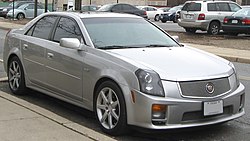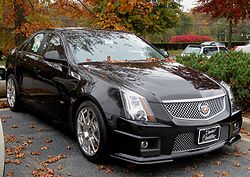Cadillac CTS
The Cadillac CTS was a mid-size Luxury vehicle manufactured by the American automaker Cadillac. It was first introduced in January 2002 as a 2003 model. The CTS was available in several body styles, including a Sedan, Coupé, and later, a Wagon version.
| Cadillac CTS | |
|---|---|
 Second-generation CTS | |
| Overview | |
| Manufacturer | General Motors |
| Production | 2002–2019 |
| Model years | 2003–2019 |
| Body and chassis | |
| Class | Mid-size luxury car (E)[1][2][3] Grand tourer (S) (CTS Coupe) |
| Chronology | |
| Predecessor | Cadillac Catera |
| Successor | Cadillac CT5 |
First Generation (2003–2007)
| First generation | |
|---|---|
 | |
| Overview | |
| Production | January 2002–June 2007 |
| Model years | 2003–2007 |
| Assembly |
|
| Designer |
|
| Body and chassis | |
| Body style | 4-door sedan |
| Layout | Front-engine, rear-wheel drive |
| Platform | GM Sigma platform/GMX320 |
| Powertrain | |
| Engine | |
| Transmission | |
| Dimensions | |
| Wheelbase | 113.4 in (2,880 mm) |
| Length | 190.1 in (4,829 mm)[6] |
| Width | 70.6 in (1,793 mm) |
| Height | 56.7 in (1,440 mm) |
| Curb weight | 3,568 lb (1,618 kg) |
The first generation of the Cadillac CTS was launched in 2002 It featured rear-wheel drive (RWD) and all-wheel drive (AWD) options and was available with a variety of V6 and V8 engines.
Second Generation(2007-2014)
| Second generation | |
|---|---|
 | |
| Overview | |
| Production | 2007–2014 |
| Model years | 2008–2013 (sedan, 2014 for V only) 2010–2014 (wagon) 2011–2014 (coupe, 2015 for V only) |
| Assembly |
|
| Designer |
|
| Body and chassis | |
| Body style |
|
| Layout | |
| Platform | GM Sigma II GMX322 (sedan) GMX206 (wagon) GMX226 (coupe) |
| Powertrain | |
| Engine | |
| Transmission | |
| Dimensions | |
| Wheelbase | 113.4 in (2,880 mm) |
| Length | 191.6 in (4,867 mm) (2008–2011 sedan) 191.3 in (4,859 mm) (2010–11 wagon) 188.5 in (4,788 mm) (coupe) 192.0 in (4,877 mm) (2012–present wagon) |
| Width | 72.5 in (1,841 mm) (sedan) 72.6 in (1,844 mm) (wagon) 74.1 in (1,882 mm) (coupe) |
| Height | 58 in (1,473 mm) (sedan) 59.1 in (1,501 mm) (wagon) 55.9 in (1,420 mm) (coupe) |
| Curb weight | 3,860 lb (1,751 kg) (sedan) |
The second generation of the CTS was introduced in July 2007 as a 2008 model. It featured updated design elements and The second generation also expanded the lineup, adding coupé and wagon versions. This generation also had features such as navigation systems and premium audio options.
Third Generation (2014–2019)
| Third generation | |
|---|---|
 | |
| Overview | |
| Production | September 2013–July 2019 |
| Model years | 2014–2019 |
| Assembly |
|
| Designer |
|
| Body and chassis | |
| Body style | 4-door sedan |
| Layout | |
| Platform | GM Alpha[10] |
| Powertrain | |
| Engine | |
| Transmission | |
| Dimensions | |
| Wheelbase | 114.6 in (2,911 mm) |
| Length | 195.5 in (4,966 mm) |
| Width | 72.2 in (1,834 mm) |
| Height | 57.2 in (1,453 mm) |
| Curb weight | 3,615–3,976 lb (1,640–1,803 kg) |
The third generation of the CTS debuted in September 2013 as a 2014 model. The third-generation CTS offered advanced safety features, larger engine options, and better handling. It was discontinued in 2019, marking the end of the CTS model in Cadillac's lineup.
Cadillac CTS Media
Cadillac CTS-V Wagon at the 2012 Paris Motor Show
References
- ↑ Mamiit, Aaron (August 3, 2015). "2016 Cadillac CTS-V: First Drive Impressions Of Experts". Tech Times.
- ↑ "2019 Cadillac CTS-V essentials: An American hot rod sedan". Autoweek. February 6, 2019.
- ↑ Neil, Dan. "Cadillac CTS-V: The world's least sedate sedan?". MarketWatch.
- ↑ 4.0 4.1 "Группа компаний Автотор :: Автомобили GM" (in русский). Avtotor.ru. Archived from the original on February 10, 2016. Retrieved November 19, 2010.
- ↑ 5.0 5.1 "GM2009". Archived from the original on September 4, 2011. Retrieved May 15, 2010.
- ↑ Newbury, Stephen (2002). The Car Design Yearbook 1. Merrell Publishers Limited. ISBN 1-85894-190-3.
- ↑ Robert Munson (May 24, 2024). "GM Designer Robert Munson". Dean's Garage.
- ↑ Wilson, Kevin A. (September 2013). "A Fine Line". Car and Driver. 59 (3): 45 Hearst Communications. ISBN 9781858941905. ISSN 0008-6002. OCLC 38224673. Archived from the original on August 21, 2013.
This CTS is the first Cadillac entirely designed under the leadership of exterior-design director Bob Boniface, who says the production model closely resembles the theme sketch penned by designer Robin Krieg
- ↑ General Motors Company (March 26, 2013). "2014 CTS Sedan Stretches Cadillac's Design Philosophy". Press release. http://media.gm.com/content/media/us/en/cadillac/vehicles/cts_sport_sedan/2014.detail.html/content/Pages/news/us/en/2013/Mar/nyas/26mar-cadillac/0326-cadillac-cts-design.html. Retrieved September 18, 2013. ""There’s an intuitive and connected feel to the cabin, with asymmetrical features that focus the controls and displays on the driver," said Eric Clough, Cadillac director of interior design."
- ↑ Zenlea, David (March 26, 2013). "2014 Cadillac CTS First Look". Automobile. Source Interlink Media. Archived from the original on December 10, 2013. Retrieved December 7, 2013.
The 2014 CTS rides on a stretched version of the Alpha platform that underpins the ATS. Compared with the current car's platform, which dates back to the first CTS, the Alpha architecture employs more lightweight materials and features much daintier components – thinner control arms, smaller fasteners.
- ↑ 11.0 11.1 Zenlea, David (March 26, 2013). "2014 Cadillac CTS First Look". Automobile. Source Interlink Media. Archived from the original on December 10, 2013. Retrieved December 7, 2013.
The 2014 CTS rides on a stretched version of the Alpha platform that underpins the ATS. Compared with the current car's platform, which dates back to the first CTS, the Alpha architecture employs more lightweight materials and features much daintier components – thinner control arms, smaller fasteners.









